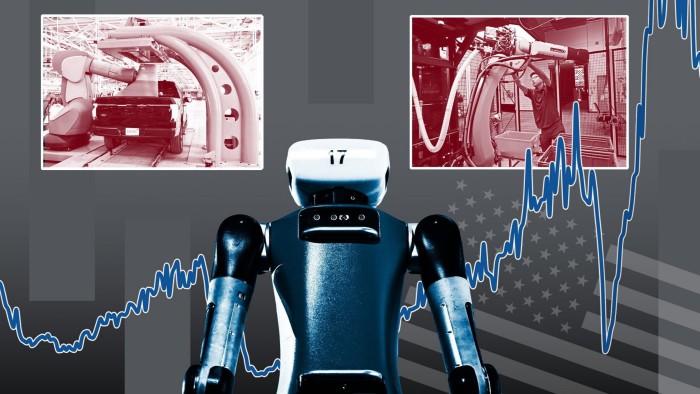From cars to iPhones to semiconductors, bringing manufacturing jobs back to the US is a cornerstone of Donald Trump’s economic agenda.
As the country’s factories struggle to find workers, with half a million jobs remaining unfilled in March, the Trump administration and some executives have envisaged robots taking up the slack.
Industry experts, however, are sceptical. Manufacturers are facing an uncertain economic climate, but the significant time, cost and the shortages of technically skilled workers are barriers to a rapid acceleration in automation.
“Companies can’t pivot on a dime,” said Ken Goldberg, a robotics professor at the University of California, Berkeley and chief scientist at US-based Ambi Robotics.
Cost is the biggest obstacle. While the price of industrial robots is rapidly declining driven by Chinese manufacturers, a lower priced type known as a “cobot” still retails for between $25,000 and $50,000.
The robot is also just a fraction of the expense of integrating automation into a factory. A robot that stacks goods on to pallets can cost up to $150,000 to install when sensors, safety fencing, conveyors and other infrastructure are taken into account, according to Jorg Hendrikx, chief executives of robotics marketplace Qviro.
Such costs put robotics out of the reach of many US manufacturers. Just 20 per cent of factories with between 50 and 150 employees have a robot, half the rate of those with more than 1,000 staff, according to the US Census Bureau.
Manufacturers are also constrained by the types of goods they produce, with robots often less economical in sectors where products change frequently, because of the required reprogramming or reconfiguration. Two in five industrial robots in the US are in the automotive sector, where lines often churn out the same high-value model year after year.
Large upfront capital expenditures, including in new facilities, will probably become less popular as the US’s economic outlook becomes more uncertain after Trump’s sweeping tariffs.
“A lot of businesses are going to put investments on hold, because you don’t know what the situation down the road will look like,” said Carl Benedikt Frey, a professor of AI and work at the Oxford Internet Institute.
“If you want to spend [on] automation, you need to be sure that this is a strategy that goes over many, many years,” said Susanne Bieller, general secretary of the International Federation of Robotics, which represents the industry.
Increased tariffs would be a “huge burden” for US companies seeking to purchase robots, she added. America relies on imports for finished robots and key components as all of the leading manufacturers, such as Switzerland’s ABB, Sino-German KUKA and Fanuc in Japan, are located outside of the US.
Experts are also critical of the “all-stick-and-no-carrot” approach the administration has taken to reshoring.
“Tariffs are punitive,” said Melonee Wise, chief product officer at humanoid robot maker Agility Robotics. “I don’t think that we’ll start seeing any kind of shift [to automation] without large or definitive incentivisation.”
Both China and South Korea have seen robot adoption surge well past the US as a result of huge government backing such as tax credits, subsidies and nationwide initiatives, such as Made in China 2025.
The US government has invested about $6bn in robotics R&D between 2018 and 2022, according to Public Spend Forum, a government research platform. However, it lacks a national robotics strategy and federal scientific research budgets are being slashed by the Trump administration.
Despite the hype around humanoid robots and those which will “self-learn” through integrated AI, these technologies were off the sophistication and price point where they could be widely deployed, said Bieller.
Increased automation will accelerate the need for workers with the skills to install and work with robotics, such as programming, systems design, engineering and maintenance, which are in global shortage.
“Manufacturers are struggling to hire qualified workers,” said Catherine Ross, a workforce development expert at the Association for Manufacturing Technology. “The education pipeline isn’t producing enough talent to meet industry needs.”
It was common for factories to have a “robot graveyard” where equipment had been mothballed because of a lack of expertise to upkeep it, said Saman Farid, chief executive and founder of “robotics-as-a-service” provider Formic.
Another complication for employers is the widespread labour union pushback against automation.
Unions representing workers as varied as delivery drivers, hotel staff and grocery store cashiers have increasingly fought to get provisions limiting the use of robots in their workplaces or requiring payouts to displaced workers. Dockworkers represented by the International Longshoremen’s Association went on strike at three dozen US ports over automation last year, costing the US economy billions.
While proponents of automation says the trend is inevitable due to the lack of labour, they still warn that it is a long way off.
“I think it’s really important to set expectations . . . [robots are] not going to be able to do a lot of tasks in the near future,” Goldberg said. “It’s a very hard problem.”
Additional reporting by Taylor Nicole Rogers








